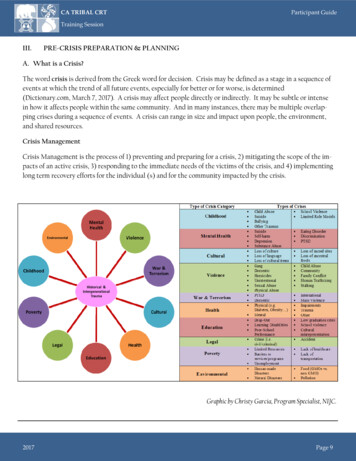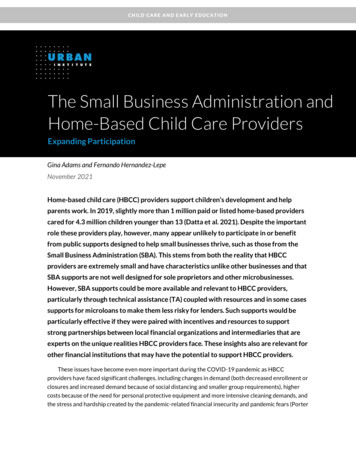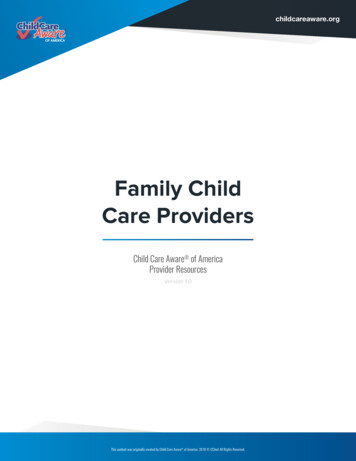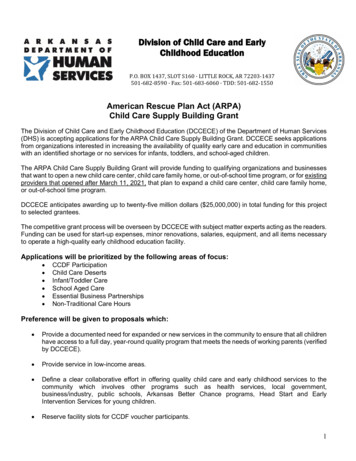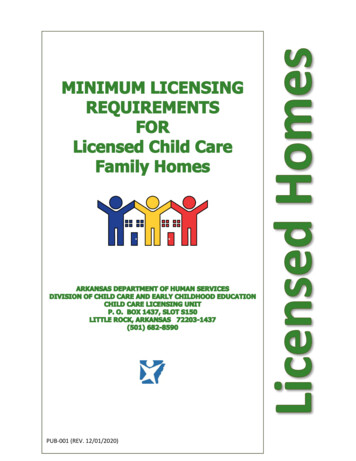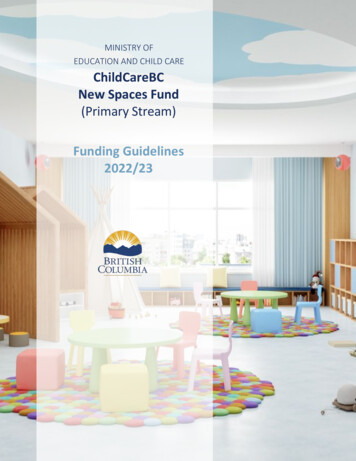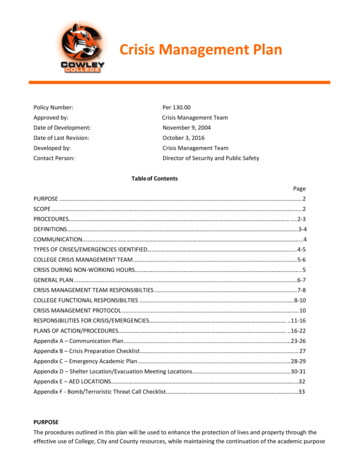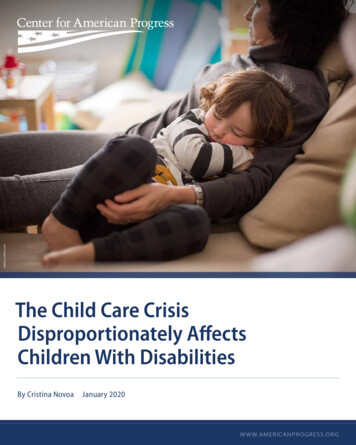
Transcription
GETTY/MAYTE TORRESThe Child Care CrisisDisproportionately AffectsChildren With DisabilitiesBy Cristina NovoaJanuary 2020W W W.AMERICANPROGRESS.ORG
The Child Care CrisisDisproportionately AffectsChildren With DisabilitiesBy Cristina NovoaJanuary 2020
Contents1 Introduction and summary4 Disability in early childhood6 Findings from the analysis13 Policy solutions16 Conclusion16 About the author16 Acknowledgments17 Appendix20 Endnotes
Introduction and summaryAuthors’ note: The disability community is rapidly evolving to using identity-first language inplace of person-first language. This is because it views disability as being a core component ofidentity, much like race and gender. Some members of the community, such as people with intellectual and developmental disabilities, prefer person-first language. In this report, the termsare used interchangeably. Direct quotes are lightly edited for clarity and length but otherwiseuse the speakers’ preferred terms.With a full-time job and a school-aged child as well as newborn twins, Alexis knewshe was going to need child care. After several days in the neonatal intensive careunit—like many twins, her babies were born prematurely and needed extra care—the hospital discharged them with no specialized support or instructions. As herbabies grew, however, Alexis noticed that one showed some muscle weakness on oneside; rolling to the left was difficult, as was holding a bottle with both hands. As sheprepared to return to work, she wondered: Could interventions like physical therapyhelp her baby? And how would that affect the kind of care the infant would need?Across the country, Missy asked herself altogether different questions. With four children at home—two preteen stepsons, a 7-year-old and a 3-year-old—juggling multipleschool and child care schedules could be overwhelming. She was fairly satisfied withher child care now that her youngest child was enrolled in preschool—a program forwhich her child is eligible under the Individuals with Disabilities Education (IDEA)Act—but challenges remained. Educators at the inclusive preschool were comfortablehandling her child’s adaptive equipment, unlike staff at their previous center. Still, theprogram ended by 2 p.m., leaving her to wonder who would watch her preschooler inthe afternoon when she has to work. Could she squeeze some additional work hoursinto her early mornings and watch her child after school?Like most parents, Alexis and Missy want to see their children thrive. Child care iscritical to this vision. Reliable, quality child care provides children with nurturinginteractions that their growing brains and bodies need while allowing parents to1Center for American Progress The Child Care Crisis Disproportionately Affects Children With Disabilities
pursue the employment and educational opportunities that undergird a family’s economic security.1 But parents of children with disabilities face meaningful obstaclesto accessing this care.The United States has failed to invest in child care for decades, leading to a dearthof affordable, high-quality options. Ableism—the intentional or unintentionaldiscrimination against people with disabilities—further compounds the child carecrisis. Nationwide, more than half of people live in child care deserts, or areas wherethe number of children under the age of 5 far outstrips the number of available childcare slots.2 However, because many of those openings are in programs that are inaccessible to children with disabilities, the share of disabled children effectively livingin child care deserts is likely higher. Programs operate on slim budgets that scarcelycover staff salaries, leading experienced early educators to seek better-paying jobselsewhere. But early childhood special education teachers—some of whom are paidfar below their general education peers—may be especially likely to leave. 3 This lackof investment in child care, coupled with poor oversight and enforcement of antidiscrimination laws designed to protect people with disabilities, mean that too manychildren are left out of care.This report examines families’ child care experiences when they have children ages 0to 5 with disabilities and offers policy solutions that are critical to supporting thesefamilies. Although the term “disability” applies to a diverse community of individuals representing a broad array of conditions and experiences, people with disabilitiesoften face similar barriers to full participation in social programs and institutions,including child care. Using quantitative data from two nationally representative surveys—the 2016 Early Childhood Program Participation Survey (ECPP) and a combined sample of the 2016–2018 National Survey of Children’s Health (NSCH)—aswell as qualitative interviews conducted in fall 2019 from a diverse sample of parentsacross the United States, the report’s analyses demonstrate that families face significant obstacles to finding appropriate child care arrangements. (see Appendix for fullmethodology) To ensure their children’s care, parents develop complicated arrangements involving formal and informal caregivers, often with significant consequencesfor careers, financial well-being, and family life.Key findings from the analysis include: ECPP data show that, compared with parents of nondisabled children, a largerproportion of parents with disabled children experience at least some difficulty findingcare (34 percent vs. 25 percent) and are unable to find care (34 percent vs. 28 percent).2Center for American Progress The Child Care Crisis Disproportionately Affects Children With Disabilities
Both ECPP survey data and interview data show that parents face numerousbarriers to care, including a lack of available slots, scheduling challenges, andconcerns about quality. Interviewed parents reported patching together help from extended family, childcare centers, special education preschool, and nurses and home health aides, as wellas making significant changes to their jobs to provide care. An analysis of NSCH data shows that, compared with parents of nondisabledchildren, parents of young children with disabilities are three times more likely toexperience job disruptions because of problems with child care. The consequences of not finding care extend far beyond job disruptions; manyinterviewed parents reported greater financial strain, health challenges, andincreased stress.It is important to note that families in which parents are themselves disabled faceadditional barriers to care. Although this report focuses only on children with disabilities, future research is needed to fully understand these families’ experiences.Why analyze multiple data sources?Disability affects how children interact with multiple programs and systems, including childcare, education, and health care. With unique emphases on early education and health,respectively, the ECPP and the NSCH provide complementary survey data about families’experiences navigating these systems. Because these datasets use nationally representativesamples, findings can be generalized to the United States’ entire childhood population.Supplementing these quantitative data with qualitative findings tells an even richer story ofparents’ experiences with child care. Whereas quantitative survey data provide informationabout number and frequency—for example, how many child care arrangements a family uses or how often a pre-K program calls a father to pick up his autistic child because ofchallenging behavior—qualitative data shed light on the meaning behind those events.4 Forexample, interviewing the father may reveal that after a month of weekly calls, he feels theprogram no longer welcomes his family, and he sees little choice but to find a new arrangement.5 (see the Appendix for additional information on the data sources)3Center for American Progress The Child Care Crisis Disproportionately Affects Children With Disabilities
Disability in early childhoodEarly childhood is a period of rapid development across physical, cognitive,social, and behavioral domains. Sometimes, however, this development followsan unexpected pattern, and children are diagnosed with a disability or delay.6These children—representing an estimated 15 percent of the United States’ childhood population—are protected by three civil rights laws: the Individuals withDisabilities Education Act (IDEA), the Americans with Disabilities Act (ADA),and Section 504 of the Rehabilitation Act.7 To educate parents about their rights,the Office of Special Education Programs* supports nearly 100 Parent Training andInformation Centers and Community Parent Resource Centers across U.S. statesand territories. These parent-led groups operate at the state level to support andinform families.8 Despite these protections and resources, families still struggle tofind appropriate child care and early learning opportunities for children when theirgrowing brains and bodies could most benefit.The IDEA guarantees early intervention (EI) services for infants and toddlers as wellas a free and public education beginning in preschool. These two programs are calledPart C and Part B, respectively, in reference to the legislative text.9 Importantly, theIDEA stipulates that children with disabilities should be in general education settingswhenever possible—a practice known as inclusion.10 Although these programs helpchildren access critical developmental and educational supports, they were developedduring a period of relatively low labor force participation for mothers and were notdesigned with working parents’ needs in mind. 11 For example, EI covers nursing andmedical services, various therapies, and parent education, but it does not includechild care for infants and toddlers—a group for whom child care options are especially scarce.12 Reliable, enriching care opportunities become more available once achild becomes eligible for preschool special education at the age of 3, but most states’programs operate on an academic calendar that leaves families to scramble for care tocover summer and other out-of-school hours.134Center for American Progress The Child Care Crisis Disproportionately Affects Children With Disabilities
Importantly, the IDEA specifies that children are eligible for services only if theyare diagnosed with a specific condition enumerated in the law.14 However, the lawallows states considerable discretion in determining eligibility criteria for diagnosesof those conditions.15 As a result, a family in Arkansas with a 3-year-old enrolledin preschool special education could find their child no longer eligible for a similarprogram if they move to neighboring Texas, a state with different, narrower eligibility criteria.16 In light of declining federal dollars for IDEA early childhood programs,states are further narrowing their eligibility criteria and focusing their dwindlingresources on serving smaller shares of children.17In contrast to the IDEA, the ADA and Section 504 of the Rehabilitation Act definedisability broadly as a physical or mental impairment that substantially limits aperson’s major life activities.18 Both laws prohibit discrimination against individuals with disabilities, including disabled children and disabled adults in need ofchild care. Specifically, the ADA stipulates that child care programs cannot excludechildren with disabilities unless including them would require a “fundamental alteration of the program” and that programs must make “reasonable modifications” tointegrate disabled individuals. Because these terms are open to interpretation—andbecause child care programs often operate with razor-thin margins that make financing accommodations difficult—children with disabilities are often excluded.195Center for American Progress The Child Care Crisis Disproportionately Affects Children With Disabilities
Findings from the analysisCAP’s analysis identified families’ obstacles to child care; illuminated the patchworkof care that families with disabled children often use; and highlighted the consequences that these families face if they cannot find care.Families’ obstacles to child care“Just in general, finding child care is hard. And trying to find child care for two is even harder.Then trying to find one for a child with special needs that’s in the perfect location—it’s evenharder still.” –AlexisA shortage of careChild care is difficult to find for all families; evidence from the ECPP suggests thatit is especially difficult for families of children with disabilities. Whereas the share offamilies reporting no difficulty finding care was similar across families with nondisabled children and families with disabled children, a larger proportion of parentswith disabled children experienced at least some difficulty finding care (34 percentvs. 25 percent) and were unable to find care (34 percent vs. 28 percent).Across the United States, parents of children with disabilities were also significantlymore likely than parents of nondisabled children to report a lack of available slotsas their main difficulty in finding care—12 percent vs. 8 percent. This finding likelymasks variation across states, given that the way each state determines eligibilitylikely affects the difficulty parents’ have finding care.6Center for American Progress The Child Care Crisis Disproportionately Affects Children With Disabilities
FIGURE 1Parents of children with disabilities struggle to find child careEstimated percentage of families reporting difficulty finding child care in 2016,by child's disability statusDisabilityNo disabilityAt least some difficulty34%25%Did not find care34%29%No difficulty4%4%Did not try to find care28%42%Source: Author's analysis of National Center for Education Statistics "2016 National Household Education Survey: Early Childhood ProgramParticipation Survey," available at https://nces.ed.gov/nhes/dataproducts.asp#2016dp (last accessed January 2020).Qualitative interview data support this finding and reveal other challenges.Throughout interviews, parents recalled tenaciously looking for child care beforetheir child’s birth. Alexis described frequent calls to providers to find care:“Sometimes you got to be the advocate. If I become a nuisance, hey! I’m a nuisancefor a reason.” Interviews also revealed that as children’s needs became clear, manyparents were compelled to revise their plans. For families of disabled children,restarting the search process is more burdensome than simply starting at the bottom of a waitlist; they must find programs that fit their child’s needs, even as theyare learning what those needs are. One first-time mother, who had already visitedseveral programs throughout her pregnancy, described a discouraging second visit toa child care program after her child was born:I asked [the provider], “Would you take a child with complex medical needs?” Andthe response was, “As long as it doesn’t disrupt the classroom.” And it just sunk myheart into my stomach because I have a 4-month-old. I don’t know what this wasgoing to look like at six months. I’ve no clue what 2 looks like for him.7Center for American Progress The Child Care Crisis Disproportionately Affects Children With Disabilities
Quality and safety concernsBeyond availability of slots, interview data reveal that parents were concerned aboutchild care providers’ experience or knowledge serving children with disabilities.For example, parents of Deaf children who were interviewed noted an absence ofproviders in their communities who were fluent in American Sign Language whileremarking how important it is for children’s language and social development tocommunicate in their language.20 In contrast, Alexis and other parents of childrenwith complex medical needs worried about providers’ ability to ensure their children’s well-being and physical safety, especially in environments where providersmust divide their attention among multiple children. Given her child’s limitedspeech, Alexis noted having to be extra “careful” in choosing trusted providers whounderstood her child’s other ways of communicating. Less sensitive providers orproviders who are stretched thin by watching large numbers of children may be lessattuned to the nonverbal cues that some children use to communicate their needs.Less frequent, but still important, were instances in which attitudinal or environmental barriers discouraged families from attending a program. Several parents expressedfrustrations about program policies, noting how these often violated the principle ofinclusion. Examples included barring children from specific activities such as playing outdoors on hot days or inappropriately holding children back with youngerpeers. Physical barriers exist as well. As a mother of two toddlers, including one witha physical disability that makes climbing steps difficult, Alexis had to eliminate anyprogram without easy ground floor access or elevators. Parents were quick to note thatthese types of barriers constitute illegal forms of discrimination, and several parentsdescribed filing complaints or undertaking legal action. Having this legal recourse,however, did not help parents address their immediate child care needs. Moreover,several parents recognized that following through with these complaints was possiblebecause they had access to resources—including existing connections to legal professionals and financial resources to pay legal fees—unavailable to all families. Althoughfiling a complaint could eventually help families gain access to care, it was often alaborious and expensive process that not all families could undertake.8Center for American Progress The Child Care Crisis Disproportionately Affects Children With Disabilities
A patchwork of care“I wake up around 4:30 a.m. or so and come down to my desk and work for a while (before mychild is awake). Without my parents helping out I’m not sure what I’d do.” –MissyMultiple child care arrangementsECPP data reveal that children with disabilities are significantly more likely than nondisabled children to receive care from multiple sources (22 percent vs 13 percent).FIGURE 2,Parents of children with disabilities use multiple kindsof child care arrangementsEstimated percentage of families regularly using different child carearrangements in 2016, by child's disability statusDisabilityNo disabilityMultiple arrangements22%13%Relative care31%26%Nonrelative care15%14%Center-based care53%34%Source: Author's analysis of National Center for Education Statistics "2016 National Household Education Survey: Early Childhood ProgramParticipation Survey," available at https://nces.ed.gov/nhes/dataproducts.asp#2016dp (last accessed January 2020).Interview data complement survey findings by capturing more fully how families of children with disabilities weave together multiple sources of care as well astheir preferences for different types of care. Interviewees often reported relyingon extended family or chosen family for child care.21 In Missy’s case, although herchild has been enrolled in a child care center since infancy, her retired parents livenearby and provide regularly scheduled care several times a week. Other interviewees described relying on a network of nearby grandparents, aunts, uncles, and closefriends—several of whom were still in the workforce—to provide last-minute care.Even sporadic care from family is critical; several interviewees described extendedvisits from out-of-town grandparents to help provide child care, especially duringstressful moments such as hospitalizations.9Center for American Progress The Child Care Crisis Disproportionately Affects Children With Disabilities
Almost half of interviewed parents reported regularly using center-based programsas part of their patchwork of care. However, center-based programs do not alwaysmeet families’ needs. Several interviewees—especially parents whose children havecomplex needs—also reported using nurses and aides, some of whom accompaniedchildren in child care.Nurses, home health aides, and child careSome children with disabilities may need around-the-clock care from a nurse or homehealth aide. To help, the federal government allows states to pay for these children’s in-homecare with Medicaid through a waiver, even if the children would not otherwise qualify forMedicaid.22 Having a nurse or home health aide available to help take care of their childgives parents more freedom to work or go to school. However, as some parents noted intheir interviews, the role of these providers is mainly to attend to children’s physical healthneeds rather than their overall development. To ensure that children benefit from enriching,developmentally appropriate activities while also receiving one-on-one professional care,some families in the Medicaid waiver programs enroll children in child care with a nurse oraide to provide additional support. Despite having the potential to be a tremendous sourceof support, interviews suggest that eligible families often find out about these programs lateand experience numerous challenges in securing and keeping these services, including onerous application processes, restrictive child care program policies, and rapid staff turnover.Future research is needed to better understand the role these supports play in families’ childcare arrangements.Parental care arrangementsNearly all interviewees reported one or more parent devoting significant time tochild care. Reasons for doing this included concerns about children’s health or safetyin group settings, scheduling constraints, program costs, and frustration with careoptions. Before Missy’s child started preschool, Missy stayed home with her twodays a week due to challenges scheduling therapy appointments—sessions requiredpulling her child out of care several times a month—concerns about program costs,and disappointment in the quality of care. “Ugh, I don’t miss the schedule jugglingwe had before preschool,” she explained in an interview. Even so, a shortened schoolday prevents her from working typical hours. “He gets dropped off by the bus at 2:15p.m.,” she said in an interview, “so we still need to be home in the afternoon.” Toaccommodate her child’s care, Missy works part time from home, squeezing in workduring odd hours and weekends while her child is asleep or in another adult’s care.10Center for American Progress The Child Care Crisis Disproportionately Affects Children With Disabilities
Parent care took many forms beyond those Missy used. One option that familiesutilized was staggering adults’ work schedules. For example, Alexis’ partner, whoworked night shifts, watched their twins during the day for a full year while Alexisworked. Another option was parental care supported through paid job-protectedleave—a benefit that many families lack. Although most parents interviewed werefortunate to have some form of leave through benefits such as vacation and paidsick days, disability insurance, and parental leave, they reported exhausting everyavailable option in order to care for their children. Importantly, parents needed totake time off work to care for their child long past the first 12 weeks of life that somecurrent paid leave proposals would cover for parents of new children.23 Anticipatingthe need to take time off later, some mothers with employer-provided time off, suchas disability or paid sick time, reported returning to work early in order to “save”their time off. Despite these challenges, this sample is relatively privileged; only19 percent of U.S. civilian workers currently have paid family leave through theiremployers, and only 40 percent have short-term disability coverage.24Consequences of not finding care“There were nights we’d be in bed and just cry because it was just hard.” –AlexisCareer sacrificesSurvey data suggest that child care struggles can affect the careers of parents withdisabled children. Many parents of young children report leaving their job, nottaking a job, or making significant changes to their job due to problems with childcare. Using a combined sample of NSCH data from 2016–2018, CAP estimates thatmore than 2 million parents of young children—nearly 1 in 10—make at least oneof these career sacrifices each year. This number rises to nearly 1 in 5, or 18 percent,for parents of children with disabilities. It is important to note that these figuresdo not take into account demographic or family characteristics that could contribute to the likelihood of parents experiencing child-care-related career disruptions.Controlling for demographic characteristics such as children’s race and gender aswell as parents’ education levels, the odds of making a career sacrifice were threetimes higher for parents of children with disabilities than parents of nondisabledchildren. Considering the disproportionately high rates of poverty among peoplewith disabilities, the additional resources that children with disabilities often need,and the onerous process of securing disability benefits for children, driving parentsout of the workforce will likely exacerbate economic inequalities between families ofdisabled and nondisabled individuals 25.11Center for American Progress The Child Care Crisis Disproportionately Affects Children With Disabilities
Interview data echo this finding and show that both mothers and fathers experiencejob disruptions. All interviewees identified as mothers and remarked upon their owncareer sacrifices, which reflects the fact that women are often the primary caregivers in their families.26 In addition, several mothers noted that their male partnersalso experienced significant changes to their work as a result of child care problems.Approximately one-third of interviewees noted that their partners scaled back orchanged their work hours, while two reported that their children’s fathers had leftthe workforce to provide child care. At least one mother noted that her husband losthis job after having to request scheduling accommodations too frequently.Other consequences of not finding child careInterviewed parents who reported avoiding advancement opportunities or neglecting to pursue different jobs due to child care problems often said that they feltfrustrated or stranded in their careers. Interviews also revealed that parents’ careersacrifices spill into other aspects of family life. For example, leaving the workforceor scaling back work hours reduces family income at a time when families are oftenshouldering other high costs associated with caring for their children. As Alexisacknowledged, it’s “not always just child care; it’s finding somewhere to live that ishard It’s buying the right shoes [for my child’s disability].”27 Beyond specializedshoes, Missy also described purchasing or modifying equipment for her child touse at the child care center to participate in group activities: floor mats to cushionher child’s head during a fall, a tricycle she modified herself, and a black blanket toreduce visual clutter and allow her child to participate in activities that would otherwise be too overwhelming.28 On average, families of children under the age of 5already spend about 10 percent of total family income on child care—more than the7 percent that the U.S. Department of Health and Human Services considers affordable.29 This figure, however, does not capture purchases such as shoes and adaptiveequipment that disabled children must often have to participate in care. A reductionin income without a corresponding reduction in child care spending would meanthat families have even less money to cover other necessities.Despite their love for their children, several parents interviewed said that they feltstressed, exhausted, and isolated at times due to a lack of support. To care for theirchildren and continue to meet their work responsibilities, several parents reportedsacrificing sleep to make up work or provide care. Most parents remarked that theirlack of sleep affected their moods or relationships, and one interviewee connectedher husband’s rare, life-threatening reaction to a common virus with the wear andtear on his body brought on by stress and sleep deprivation.12Center for American Progress The Child Care Crisis Disproportionately Affects Children With Disabilities
Policy solutionsChild care—including child care for children with disabilities—suffers from years ofchronic underinvestment. Indeed, federal funding for child care has remained largelystagnant over the past 15 years.30 Meanwhile, policymakers and program leaders atall levels have neglected to implement practices and policies that would ensure careis truly accessible to all. As a result, children lose out on valuable education and earlyintervention services that help them thrive, and parents lose out on a dependablecare arrangement that allows them to pursue meaningful opportunities, includingfurther education and stable employment. Federal action is needed to help ensurethat families of children with disabilities have access to the resources they deserve.Congress can address many of the challenges raised in this report by taking thefollowing actions.Invest in child care by passing the Child Care for Working Families ActFixing the child care system requires a comprehensive approach such as that offeredby the Child Care for Working Families Act, a bill introduced by Sen. Patty Murray(D-WA) and Rep. Bobby Scott (D-VA).31 In addition to making child care more reliable and affordable for all families through significant investments in the child caresystem, the act includes several provisions to ensure that child care is high qualityand inclusive of all children, including those with disabilities.First, it would increase the supply of accessible care by requiring states to useresources to expand inclusive child care options; creating a new funding stream toprovide early intervention services in child care setti
"Just in general, finding child care is hard. And trying to find child care for two is even harder. Then trying to find one for a child with special needs that's in the perfect location—it's even harder still." -Alexis A shortage of care Child care is difficult to find for all families; evidence from the ECPP suggests that



